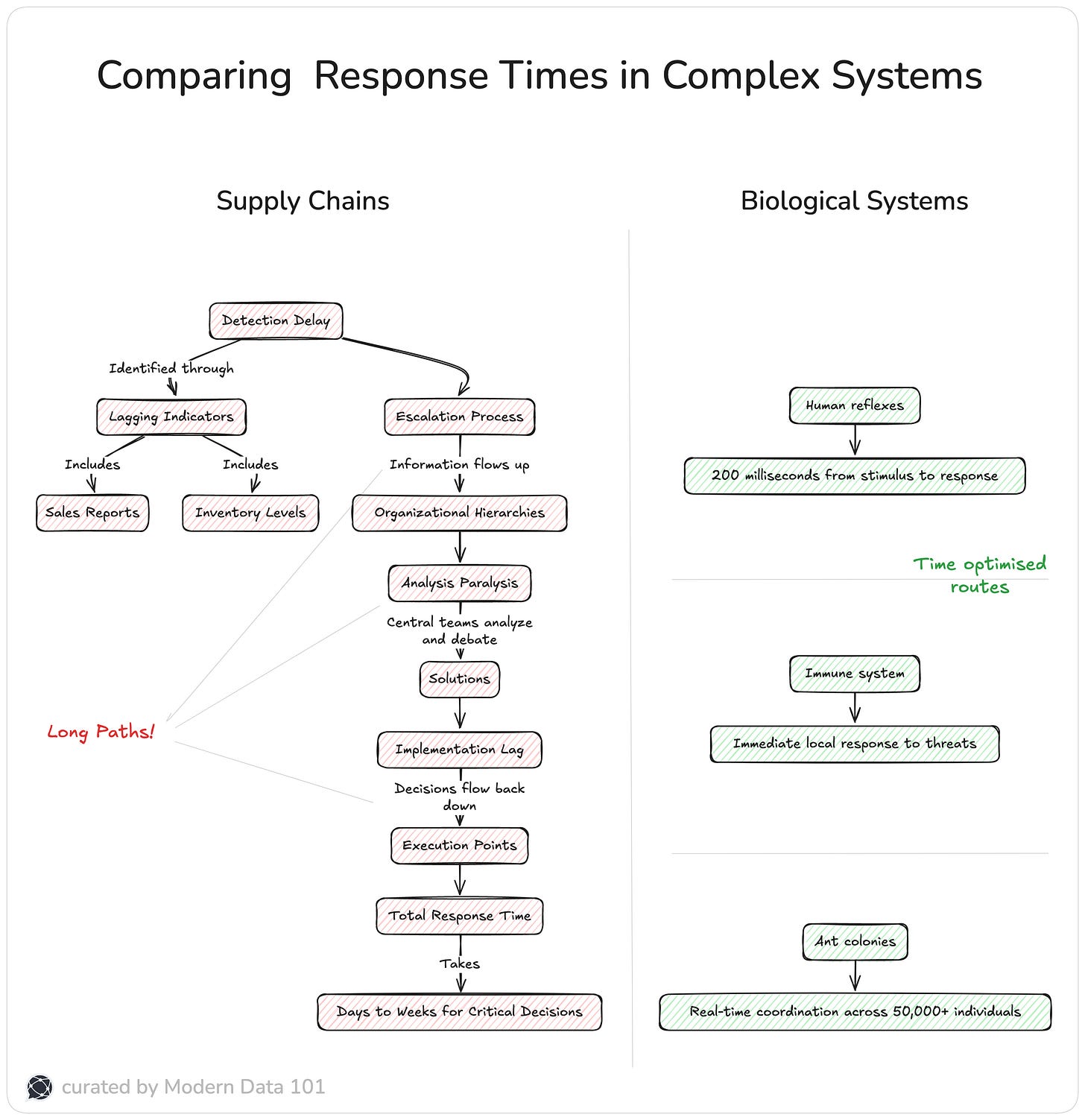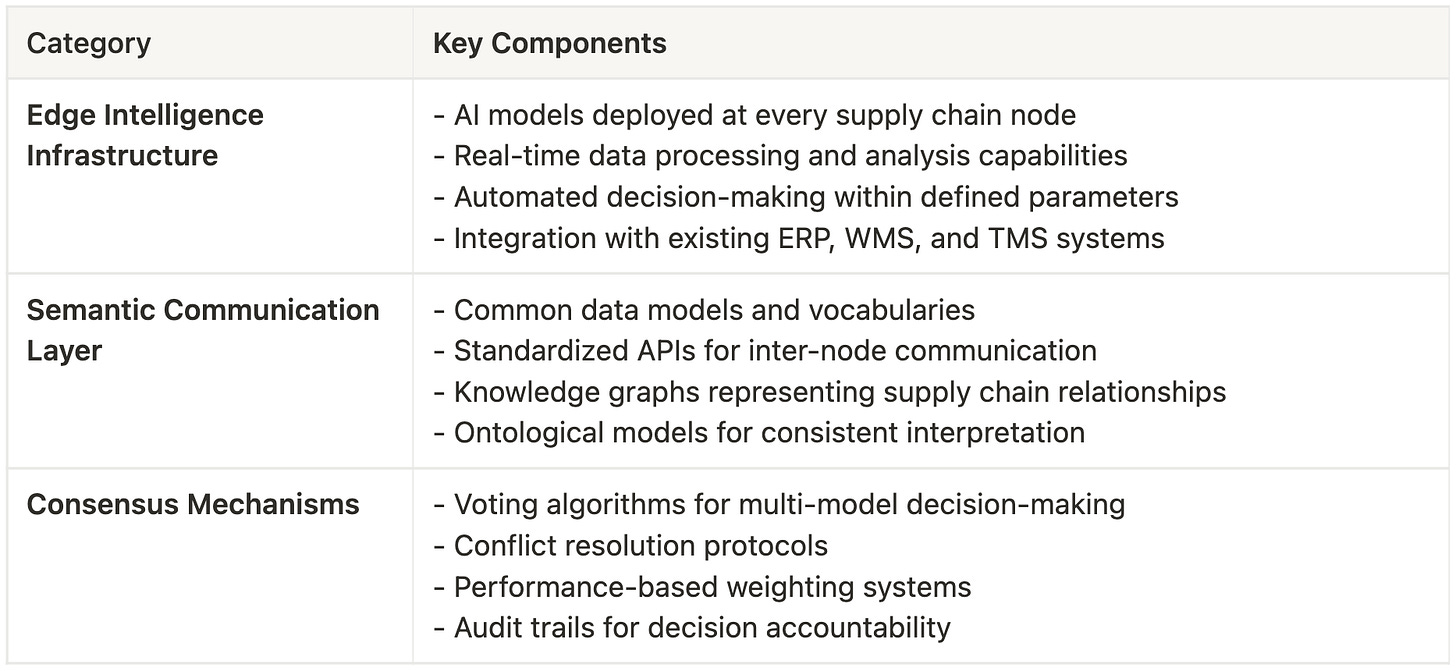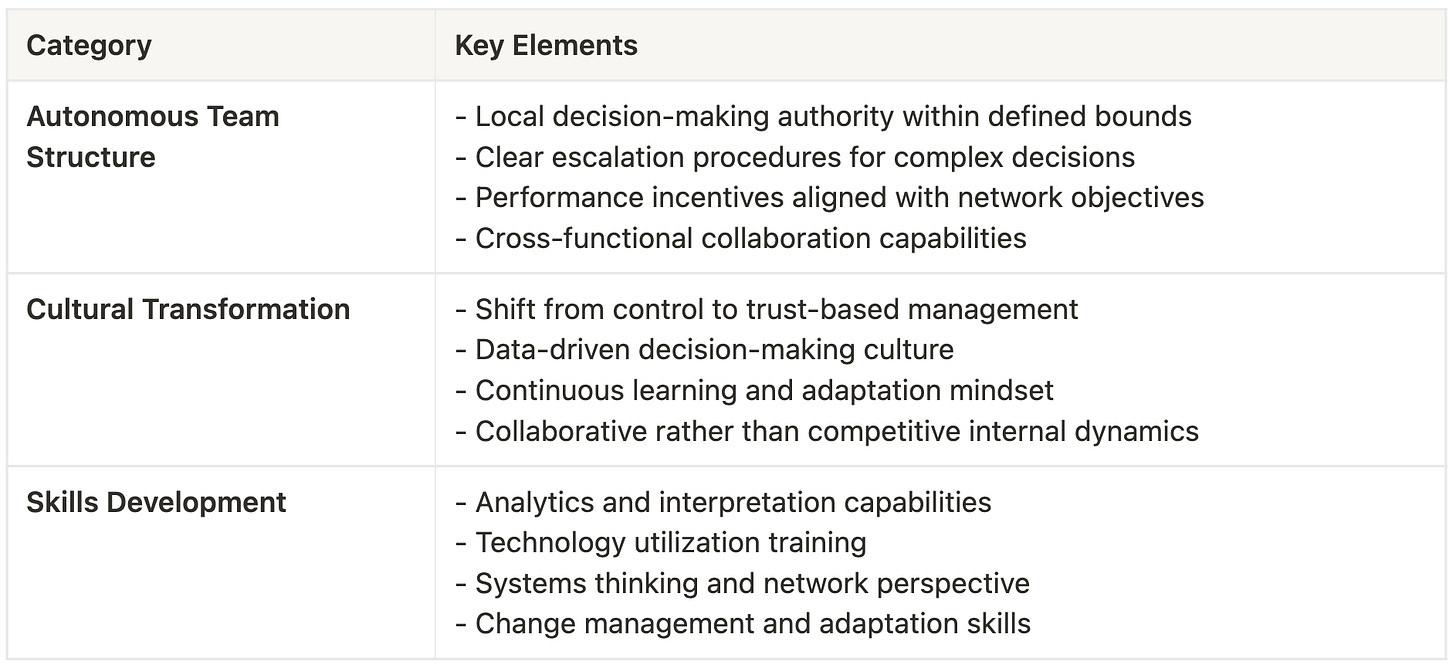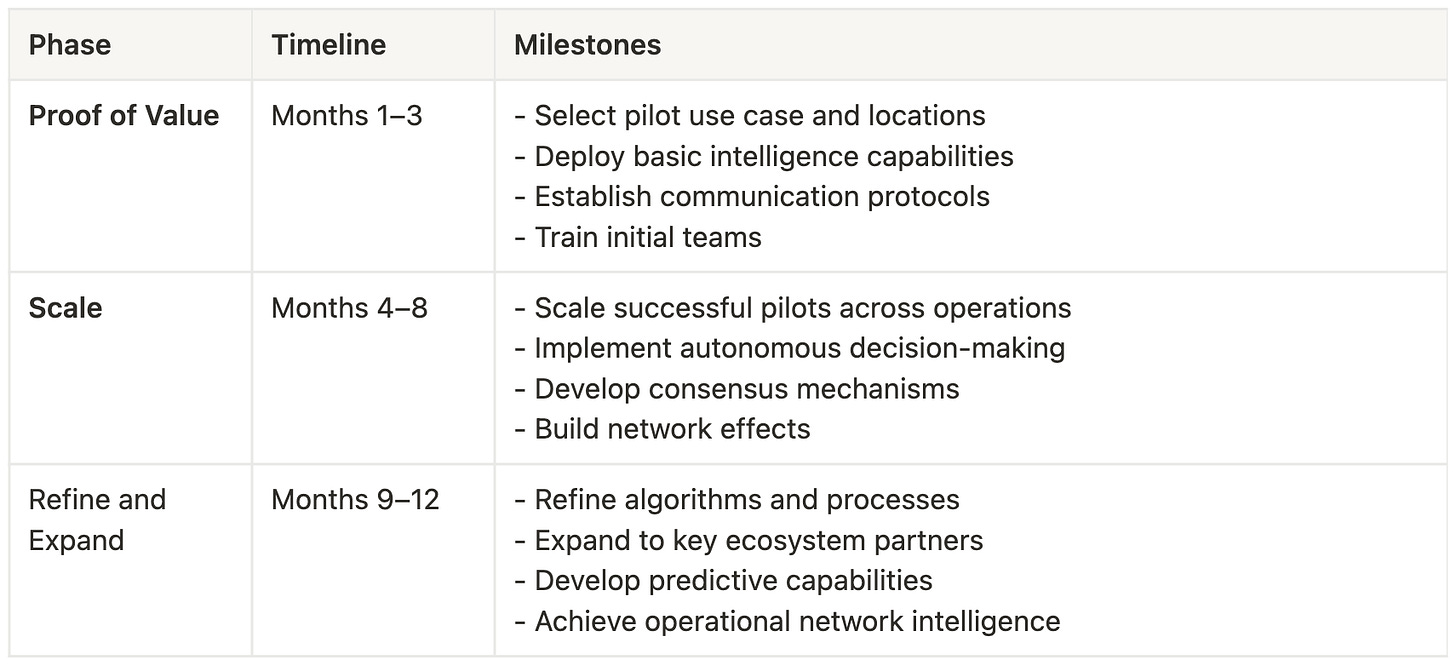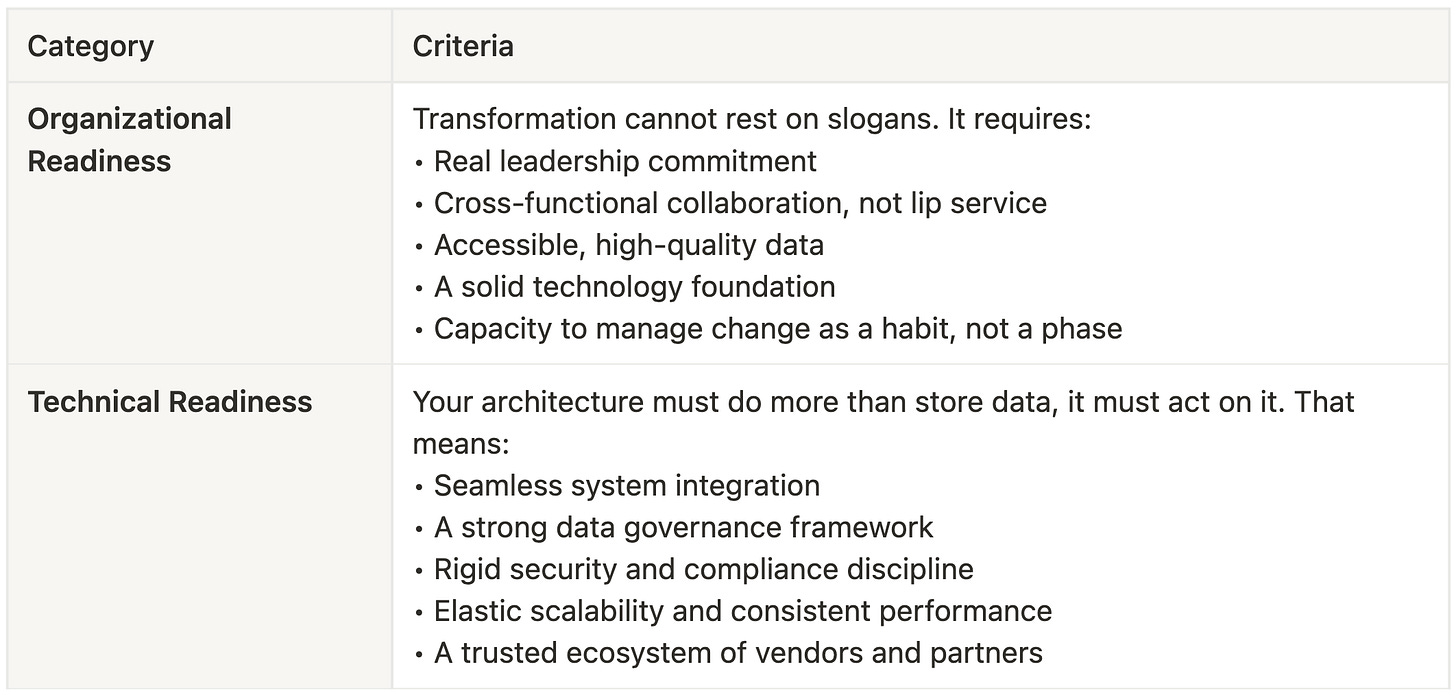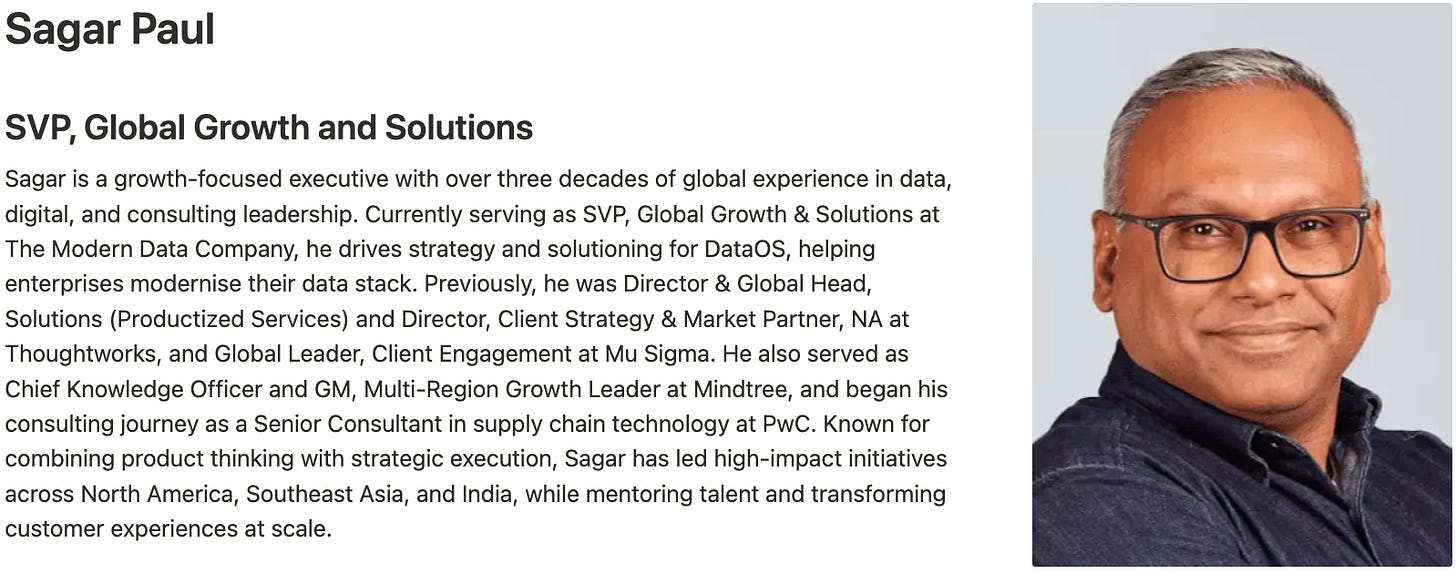Building "Thousand Brains" Data Systems: Designing Reflex with Edge Intelligence
A Demonstration with Complexities of Supply Chains, Biological Blueprints, and the Implementation Framework to Get Started and Scale
This piece is a community contribution from Sagar Paul, SVP of Global Growth & Solutions at The Modern Data Company. With over 30 years of experience across data, digital, and consulting leadership, Sagar brings a rare blend of product thinking and strategic execution. He has previously held leadership roles at Thoughtworks, Mu Sigma, and Mindtree, and has driven transformation initiatives across North America, Southeast Asia, and India. We deeply appreciate his contribution and commitment to sharing his expertise with Modern Data 101.
We actively collaborate with data experts to bring the best resources to a 10,000+ strong community of data practitioners. If you have something to say on Modern Data practices & innovations, feel free to reach out!
🫴🏻 Share your ideas and work: community@moderndata101.com
*Note: Opinions expressed in contributions are not our own and are only curated by us for broader access and discussion. All submissions are vetted for quality & relevance. We keep it information-first and do not support any promotions, paid or otherwise!
In this piece, we’ll talk in the context of supply chains to demonstrate the resilience of a “thousand brains” data stack. A system that is truly intelligent and mimics biological blueprints with “edge intelligence”: smart, decisive, and actionable abilities at the distributed end-points of large systems instead of all control locked inside a “central” brain.
Let’s dive in
The pandemic exposed a fundamental design flaw in modern supply chains: they are brittle, centralized systems that fail catastrophically when faced with unexpected disruptions. From toilet paper shortages to automotive chip crises, these failures revealed that traditional supply chain management (built on centralized planning and reactive responses) is no longer adequate for our interconnected, fast-moving world.
This paper introduces a revolutionary approach inspired by neuroscience and natural systems: the Thousand Brains Supply Chain. Based on Santiago Ramón y Cajal's 1899 discovery that the brain operates through billions of independent decision-making units rather than centralized control, and Jeff Hawkins' recent "Thousand Brains" theory, this approach enables supply chains to exhibit biological-level intelligence, adaptability, and resilience.
Key Insights:
Human brains react to stimuli in 200 milliseconds, while supply chains take days or weeks to respond to disruptions
Nature's most resilient systems (immune systems, ant colonies, forest ecosystems) operate through distributed intelligence, not centralized control
Modern technology enables the deployment of intelligent decision-making at every supply chain node
The Paradigm Shift
From centralized planning and reactive responses to distributed intelligence and predictive adaptation. This transformation moves supply chains from fragile optimization to antifragile resilience: systems that become stronger through stress rather than weaker.
The Fragility Crisis of 2020
The pandemic didn’t just expose cracks but shattered brittle systems that were never built to bend. A global stress test no one signed up for, but almost everyone failed.
Take the toilet paper paradox. Consumption didn’t spike, but usage shifted from offices to homes. But supply chains, optimized for hyper-efficiency instead of flexibility, crumbled under that minor reroute. A temporary demand reduction led manufacturers to cancel chip orders. When demand rebounded, they found themselves at the back of a two-year queue, forcing production shutdowns and billions in losses.
Rental car companies offloaded fleets to survive, only to find themselves stranded when travel rebounded. Used car prices surged, and fleets stayed empty. Homebuilders raced to meet demand, but were brought to a standstill by garage doors. Yes, garage doors. Without them, occupancy permits stalled. Entire houses sat finished but unusable.
All of these breakdowns point to a deeper issue: centralized systems that can’t handle distributed disruption. We designed for control. What we needed was resilience.
Traditional Response Patterns of Complex Systems
Detection Delay: Problems identified through lagging indicators (sales reports, inventory levels)
Escalation Process: Information flows up organizational hierarchies
Analysis Paralysis: Central teams analyze and debate solutions
Implementation Lag: Decisions flow back down to execution points
Total Response Time: Days to weeks for critical decisions
Compare this to biological systems:
Human reflexes: 200 milliseconds from stimulus to response
Immune system: Immediate local response to threats
Ant colonies: Real-time coordination across 50,000+ individuals
The gap between biological intelligence and supply chain intelligence represents a massive opportunity for competitive advantage.
Why Traditional Supply Chains Break Under Pressure
Most supply chains today still operate like rigid bureaucracies in a world that demands agility. They rely on monolithic planning systems, slow-moving information, and mechanical response protocols, all of which are incompatible with how fast disruptions travel. What was once considered “good enough” planning now reveals itself as a liability, especially when speed, decentralization, and local intelligence determine resilience.
Centralized Planning Bottlenecks
At the heart of the problem lies a decades-old assumption: that a central brain can orchestrate the chaos of global operations. But when forecasts are built in back offices and updated only in overnight batch runs, real-world markets have already moved on. Central teams, no matter how sophisticated, can’t detect the nuances of a festival spike in Mumbai or a logistics choke in São Paulo. Meanwhile, regional managers (those closest to the problem) remain powerless, buried under escalation ladders and decision-making protocols that prioritize alignment over action.
Information Latency Problems
Signals that should trigger decisions: inventory shortfalls, supplier hiccups, demand surges, etc. take far too long to surface. Systems still rely on past sales to guess the future, missing the early tremors that frontline staff and POS data might offer. By the time an exception hits the dashboard, it’s often too late. Optimization engines, fed by stale or averaged data, continue to make globally efficient but locally irrelevant decisions: failing to see that what works in New York may stall in Nairobi.
Rigid Response Mechanisms
Even when the data arrives, the response muscle is brittle. Organizations lean on SOPs built for predictability, not adaptability. Most exceptions require manual overrides, emails, and approvals, slowing everything down. Successful improvisations at the edge, instead of becoming institutional knowledge, stay trapped in individual teams. And by the time one region discovers a clever fix, it rarely travels fast enough to help another. The system doesn’t learn, it lags.
.
What Natural Intelligence Can Teach Us About System Design
For over a century, we’ve misunderstood how intelligence works, both in humans and in the systems we build. We assumed intelligence meant central control, that one brain or one team, or one system, should process everything and issue orders. But nature tells a different story. In 1899, Santiago Ramón y Cajal’s microscope showed us that the brain isn’t a command centre but a network. It only looked like a central unit. Billions of autonomous neurons, each acting on local signals, collaborate to form intelligent behavior.
This wasn’t just a scientific breakthrough; it was a blueprint for systems design!
The Thousand Brains Insight
Jeff Hawkins' “Thousand Brains” theory reframes how we think about intelligence entirely. It turns out our brain doesn’t rely on a single model of the world. It builds thousands of them in parallel, much like a Random Forest algorithm. Each cortical column (one of the brain’s tiny, repeating structures) creates its own interpretation of what’s happening.
These columns don't wait for orders; they vote, constantly, in real-time, using shared sensory inputs to reach a consensus.
Intelligence, then, is not the result of top-down orchestration but a fluid negotiation between independent, self-sufficient agents.
Why This Matters for Systems
Imagine designing organizations, platforms, or supply chains with the same principles: local models, distributed decision-making, and consensus through interaction instead of hierarchy. The brain doesn’t escalate issues up a chain of command. It resolves them on the edge.
Each part is intelligent because each part understands its environment. If our systems could mimic this, enabling every node sense, model, and act, we’d trade brittleness for resilience, latency for speed, and rigid planning for real-time adaptation. This is neuroscience applied to complex data systems, much like the application of game theory to economics.
Key Conclusions
Distributed Processing: No single "CEO" neuron controls decisions
Local Expertise: Each cortical column specializes in specific patterns
Voting Mechanisms: Decisions emerge from competition between models
Continuous Learning: Each column updates its model based on outcomes
Parallel Processing: Multiple decisions happen simultaneously
Your brain manages far more complexity than any supply chain, yet operates with sub-second response times through distributed intelligence.
Let’s also look at few of nature’s distributed intelligence systems.
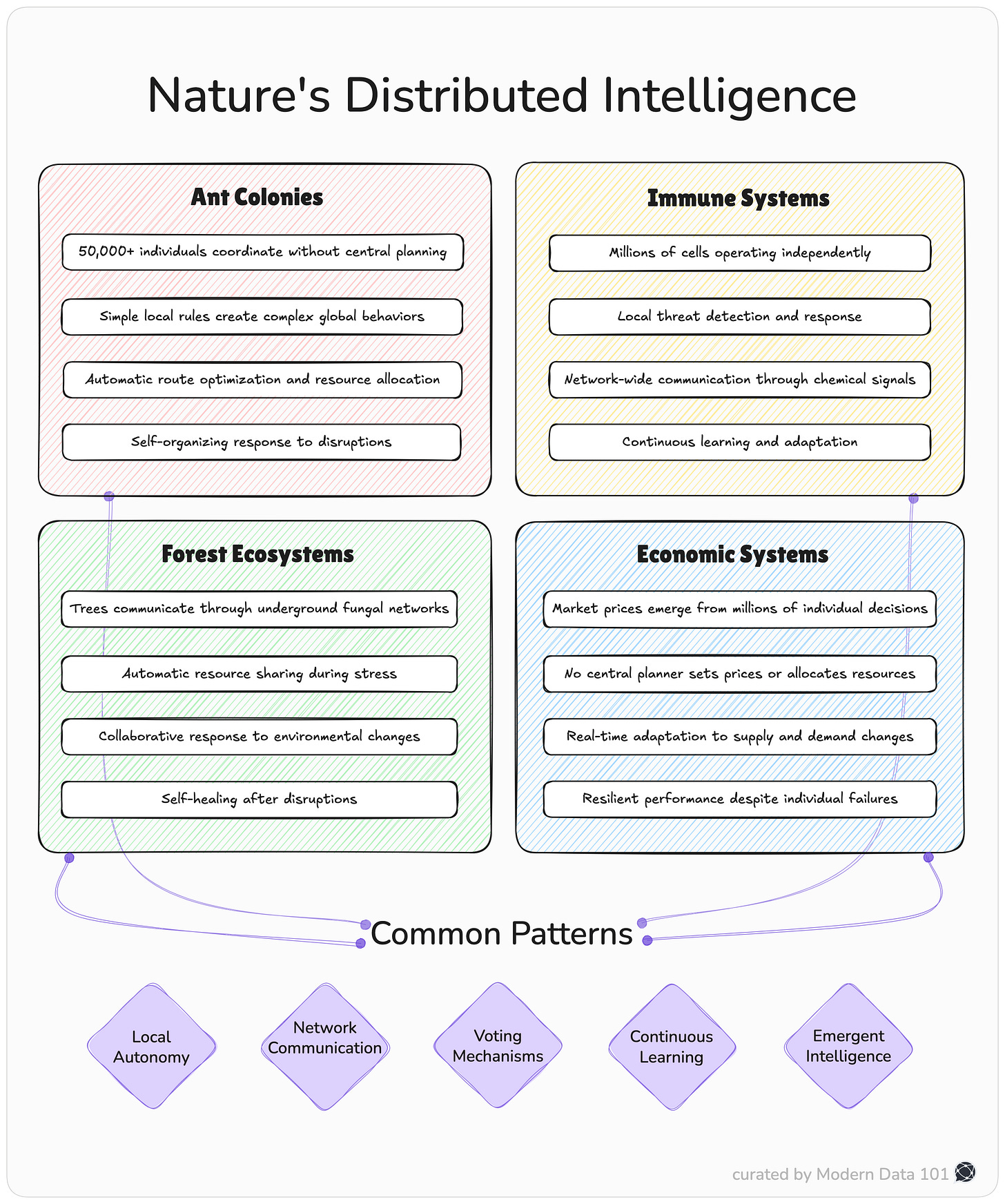
The common patterns emerge easily. All resilient systems share these characteristics:
Local Autonomy: Individual agents make decisions based on local information
Network Communication: Information flows throughout the system
Voting Mechanisms: Multiple perspectives compete to find optimal solutions
Continuous Learning: Performance improves through experience
Emergent Intelligence: Complex behaviors emerge from simple rules
.
The Thousand Brains Supply Chain Vision
The Thousand Brains Supply Chain reimagines how modern supply networks should operate: modeled not on command-and-control hierarchies, but on how intelligence naturally emerges in the brain. In this paradigm, intelligence is distributed at every node, allowing each part of the network to sense, decide, and act independently.
Instead of reacting to disruptions like traditional chains, the system adapts predictively and proactively. Decisions are taken in parallel (not in sequence), with multiple models across teams, regions, and data layers competing and voting in real-time.
This decentralized model optimizes for resilience and adaptability. And instead of pushing information up a narrow chain of command, insights and signals flow fluidly throughout the entire network, enabling fast, localized, and informed responses.
Let’s look at the transition right next to each other.
The 5 Core Principles of the Thousand Brains Supply Chain
Edge Intelligence
Deploy AI models at every supply chain node: warehouses, stores, suppliers, transportation hubs. Each location becomes an intelligent decision-making unit rather than a passive execution point.
Consensus Mechanisms
Multiple models at each node generate predictions and recommendations. These compete and vote to determine optimal decisions, similar to how cortical columns operate in the brain.
Semantic Communication
Establish common vocabularies and communication protocols that enable different parts of the network to share information effectively without requiring centralized interpretation.
Autonomous Teams
Empower local teams to make decisions within defined parameters, supported by intelligent systems that provide real-time insights and recommendations.
Network Effects
Measure success based on overall network performance rather than individual node optimization, encouraging collaboration and system-wide thinking.
Three Examples of Application
Demand Sensing
Every retail location, warehouse, and supplier maintains its own demand prediction model. These models vote to create consensus forecasts while maintaining local expertise.
Example: A fashion retailer's Munich store detects early demand signals for winter coats through website behavior, weather forecasts, and local event calendars. It automatically adjusts inventory and pricing without waiting for central planning cycles.
Risk Management
Each supplier, logistics provider, and facility continuously models potential disruptions. The network automatically reroutes when nodes predict problems.
Example: A supplier's financial health model detects early warning signs of cash flow problems. The system automatically activates backup suppliers and adjusts order timing to prevent disruption.
Inventory Optimization
Inventory positions are optimized not just locally, but through network-wide intelligence that considers upstream and downstream implications.
Example: Excess inventory in one location automatically flows to areas with increasing demand, optimizing working capital and service levels across the entire network.
.
Implementation Framework for the Thousand Brains Stack
Technical Architecture Requirements
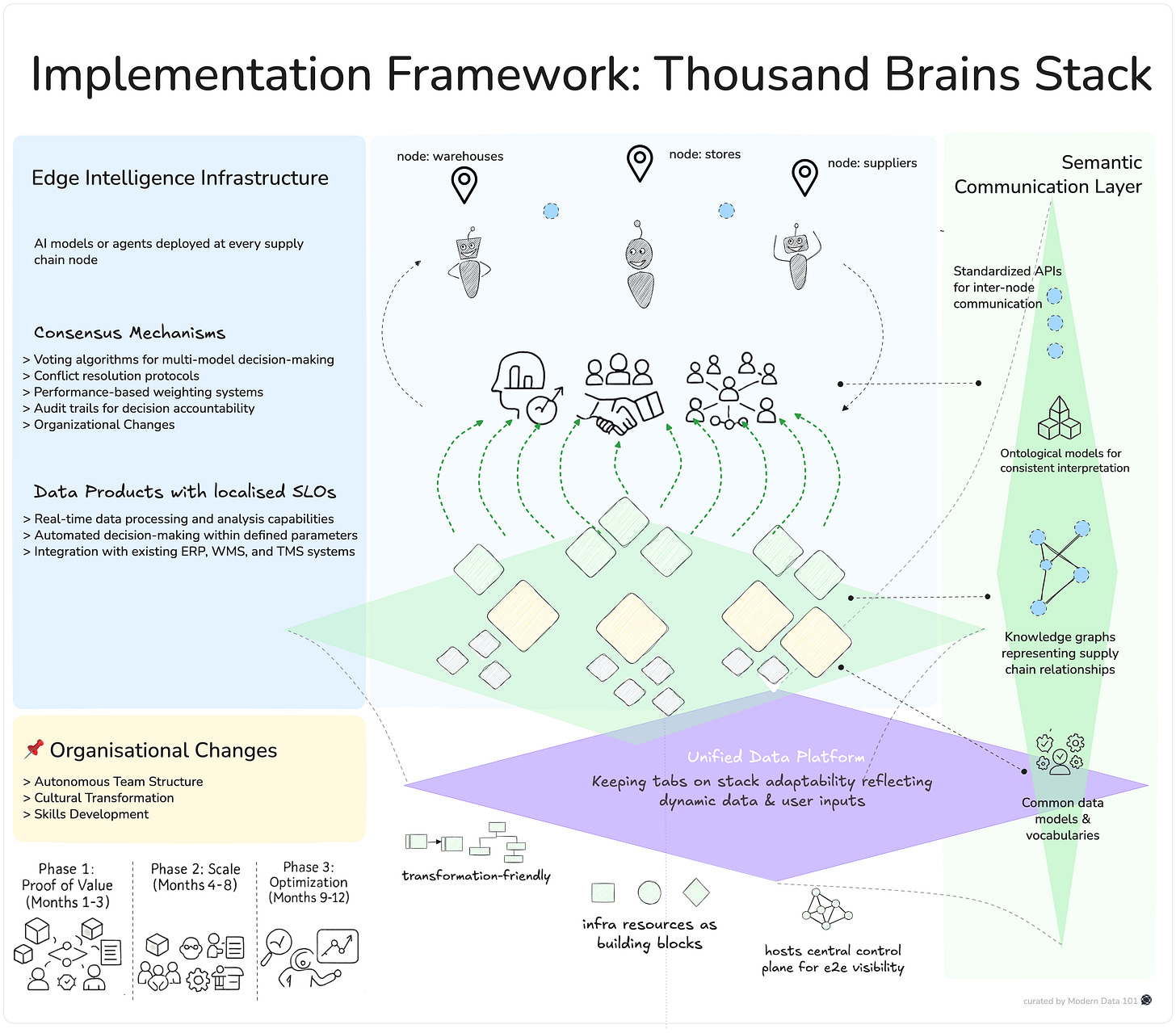
Organizational Changes
Implementation Roadmap
.
Addressing Leadership Concerns: Safeguarding Initiatives in the Age of Distributed Intelligence
The shift to distributed decision-making isn’t optional anymore. But leaders worry: How do we decentralize without losing control? The key is separating principles from processes. Define what must never change, say, customer promises, quality standards, regulatory boundaries. Then give teams the freedom to adapt the how based on ground realities. That’s context-aware execution.
Think Starbucks. It doesn’t script every store’s day. But the brand feel, the standard of service: they are sacred and non-negotiable. Local decisions happen daily, but the promise holds steady.
What makes this model resilient is real-time feedback. Leaders don’t need to micromanage if systems surface deviations instantly. Then it's not about fixing the team but about adjusting the boundary.
Shared Principles, Not Shared Decisions
Outcome-Based Standards: Say what good looks like, not how to get there
Real-Time Coordination: Let nodes sense and respond in sync
Intelligent Guardrails: Escalate only when necessary
Continuous Learning: Share what works across the network
Distributed doesn’t mean disjointed. With the right scaffolding, decentralization becomes a strength instead of a risk. Done right, the system doesn’t just survive pressure. It learns from it.
Human Organizational Parallels
Do these lessons apply beyond supply chains to organizational structure and team management? Absolutely. The thousand brains model reflects how humans naturally organize when most effective.
Organizational Applications:
Squad Models: Small, autonomous teams with clear missions (like Spotify)
Network Organizations: Information and decision-making distributed throughout the organization
Innovation at the Edges: Empowering front-line teams to identify and solve problems
Jazz Band Management: Everyone knows the song, but there's room for individual brilliance
Humans are already wired for distributed intelligence. Traditional hierarchies fight our natural capabilities rather than leveraging them.
.
The Consequent Customer Experience Revolution
Data-Driven Meaningful Experiences
The Traditional Approach: Collect customer data → Send to headquarters → Analyze monthly → Adjust strategy quarterly
The Thousand Brains Approach: Every customer interaction becomes a learning moment that immediately improves the next interaction.
Real-Time Intelligence in Action
E-commerce Example: A customer browses winter coats on your website. Instead of showing generic recommendations, the system instantly considers weather forecast, local events happening this weekend, current inventory levels, competitor pricing, real-time browsing patterns, and the like.
The system then automatically adjusts pricing, inventory positioning, and shipping options to create the perfect experience.
Customer Experience Result
Never seeing "out of stock" on exactly what they need, when they need it.
Three Levels of Meaningful Experience
Predictive: Anticipating needs before customers express them
Contextual: Understanding the full situation, not just the purchase
Seamless: Making the complex simple on the customer side
Data disappears into seamless, intelligent experiences.
Like your brain managing breathing without conscious thought, great customer experiences don't make customers think about the complexity behind them.
.
Your Supply Chain Won’t Evolve Itself. Start Building Its Reflexes
The Strategic Imperative
The shift from fragile to reflexive supply chains isn’t optional, it’s inevitable. The question is whether you will lead that transition or trail behind it.
Why now?
Disruptions are more frequent. Customer expectations are non-negotiable. Competitors born in the cloud are moving faster than legacy systems can react. Meanwhile, the technology to respond intelligently, autonomously, adaptively already exists.
Readiness Assessment
Reflexive supply chains are built on two foundations: organizational alignment and technical agility. Before you launch anything, assess both with brutal honesty.
Implementation Strategy
Start Small, Think Big
Design for traction. Start with a narrow, high-impact area: one product line, one geography, one problem. Prioritize measurable outcomes over perfection. Earn confidence through early wins and expand rapidly within 12 months.
Pilot Selection Criteria
Not every use case qualifies. Choose pilots that:
✅ Have visible business impact
✅ Are supported by clean, available data
✅ Are operationally contained
✅ Enjoy stakeholder backing
✅ Deliver measurable outcomes within 90 days
Success Factors
Execution beats ambition. The pilots that thrive will have active executive sponsorship, engaged cross-functional teams, clear metrics and tight timelines, thorough training and change support, and continuous monitoring and rapid adjustment.
The Roadmap to Designing Reflexes
The Transformation Begins Now
The technology exists, the business case is proven, the competitive advantage is clear, and the biological blueprints are available. The only remaining question is whether an organization will embrace the future of supply chain intelligence or be forced to adapt to it.
Organisations building thousand brains stacks already have insurmountable competitive advantage in the AI-era. While others struggle with the next disruption and “migration”, they will be adapting automatically, learning continuously, and serving customers 10x better experiences.
.
Final Note: From Fragile to Antifragile
The journey from fragile to reflexive supply chains represents more than a technological upgrade. This is a significant inflexion point to both observe and fundamentally reimagine how intelligent systems operate in an uncertain world. By learning from billions of years of biological evolution and applying those lessons through modern technology, we can create supply chains that thrive because of disruptions.
The thousand brains approach offers a path that's deeply rooted in natural principles. It promises supply chains that are:
Intelligent: Making smart decisions at every node
Adaptive: Responding quickly to changing conditions
Resilient: Continuing to operate despite disruptions
Learning: Improving continuously through experience
Collaborative: Working towards common goals
This transformation requires agency to move beyond traditional control-based or centralised management, wisdom to implement changes thoughtfully, and persistence to see the journey through. But for organizations that embrace this approach, the rewards are substantial: customer loyalty, operational excellence, and the satisfaction of building systems that truly serve human needs.
The future belongs to organizations that combine human intelligence with technological capability, creating supply chains that are truly intelligent.
These insights are from my time at Radial
And here are some more interesting conversations I had the opportunity to join...

Leonardo Antonio Avezzano reminded us that in an age of data-driven everything, compelling narratives still move markets and build lasting relationships. Stephan Kettemann and Stephan F. brought perspective on the operational realities that make seamless fulfilment possible. Pieter Van den Broecke from Manhattan Associates shared very interesting research on how unified commerce platforms generate memorable customer experiences, something we see in our daily operations. Liubov Timofeeva made a compelling case for authentic brand personality. Valentino Caporizzi challenged our thinking on e-commerce's invisible but transformative role in reshaping entire industries and customer expectations. And Mary Roder brought it all home with powerful stories about trust, teamwork, and transformation that resonated with everyone in the room.
~ an excerpt from the Radial community that sums up some of the highlights of the meetup.
MD101 Support ☎️
If you have any queries about the piece, feel free to connect with the author(s). Or feel free to connect with the MD101 team directly at community@moderndata101.com 🧡
Author Connect 🖋️
Connect with me on LinkedIn 🤝🏻
From MD101 🧡
The Modern Data Survey Report: By the Community, for the Community
230+ Industry voices with 15+ years of experience on average and from across 48 Countries came together to participate in the first edition of the Modern Data Survey. And together, we uncovered the truths beneath the hype cycles.
Located specific time sinkholes
Uncovered recurrent and unnecessary tooling gaps
Projected the Desired Data Stack in NEED
And much more!
Get your copy and share your insights with us 🧡


